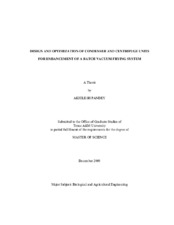| dc.description.abstract | A batch vacuum frying system, which processes fruits and vegetables, includes a frying pan, a surface-condenser, and a vacuum pump. With health and safety issues in mind, this research focused on developing a modified surface-condenser to prevent cavitation of the vacuum pump. The final oil-content was reduced by centrifugal de- oiling of the product under vacuum, which make the product healthier than what is currently available.
The de-oiling mechanism consists of a centrifuge with a motor attached to the basket shaft, rotating up to 750 rpm (63 g units). The condenser consists of a (counter- flow) spiral-coil heat exchanger (SHE) connected to a refrigeration system that uses R404a refrigerant.
De-oiling for 40 s at 300 and 750 RPM removed up to 67% and 72% of the chip’s surface oil, respectively. At 750 RPM for 10 s, 40 s, and 60 s the oil-content was reduced by 38%, 44%, and 51%, respectively.
The convective heat transfer coefficient (h) of the frying oil was determined at 120°C and 140°C using the lumped capacitance method. The h-values were 217±13 W/m2K (120°C) and 258±37 W/m2K (140°C) using a copper-ball thermocouple. The h- values increased to 3.6 times during the boiling period.
COMSOLTM Multiphysics was used to model the heat transfer in the vacuum fryer pan. Based on the simulation results, a 1.5 cm thick insulation material was installed in the fryer to reduce the energy losses.
The refrigeration system operates at Tevap = -26°C and Tcond = 50°C with 26°C sub-cooling. Sensitivity analysis showed that the system Coefficient of Performance (COP) was about 3.87 at these conditions and compressor power requirement (CPR) was 74 W (85% efficiency) when frying 30 g of potatoes slices. The best results were obtained at Tevap = -10°C and Tcond = 40°C with 26°C sub-cooling and superheat of 5°C. The predicted COP was 4 and the CPR 70 W.
The ice-formation on coils reduced the condensation rate. Reducing the refrigerant temperature to -10°C (from -26°C) reduced the condensation rate by 30%.
These results show a more effective vacuum frying system for high-quality fruits and vegetables than the system previously used. | en |


